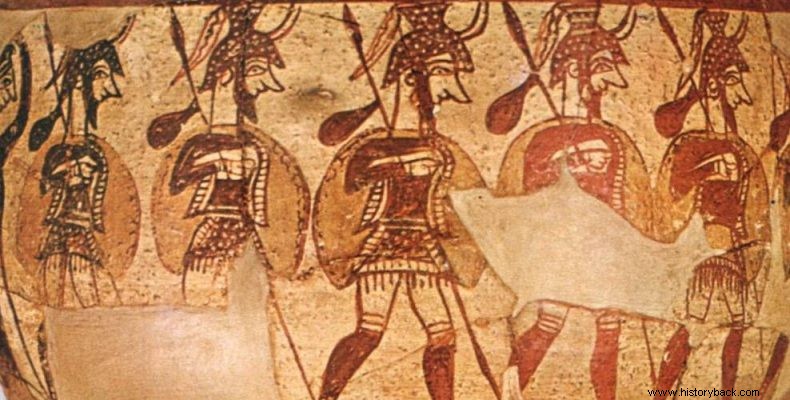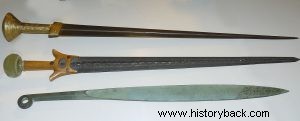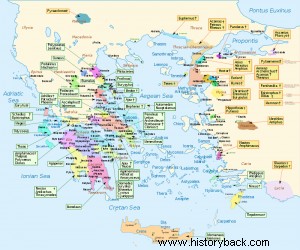
Sons of the Achaeans, Homer the Great calls the heroes of his epics, who started from the land of stone and light, Greece, to conquer the divine Ilios, the glorious city of Priam. But who were these sons of the Achaeans? The Achaeans were an Aeolian race. Scholars argue that the epithet indicates the mixing of the proto-Greek races from which the Aeolian race originated.
Epirus is considered their first cradle and their presence there is associated with the most ancient Greek sanctuary, that of Dodoni. According to some Achaios was the man of rivers and seas. The Achaeans were excellent warriors. They knew the horse and had tamed it from an early age, at least since they came down to the Thessalian plain.
The Achaeans were a seafaring people. In a tomb of Burial Circle A of the acropolis of Mycenae, which you date between 1,600-1,500 BC. beads of electrum were found, which existed only on the shores of the Baltic Sea.
Mycenaean weapons were found in almost all of Europe, from Pomerania in present-day Germany, to the Jutland peninsula, in Denmark, in the Hungarian plains, in the present-day Czech Republic, in Romania, Albania, and even in the British Isles. strong>
The Mycenaeans, having crossed the Bosphorus Straits, had reached the Black Sea, from which they procured precious metals and grain. From there, sailing through the Danube, they reached the heart of central Europe.
Consolidation and expansion
From the 17th century BC the Achaeans gradually spread throughout Greece and took over the reins of the country. Almost two centuries had to pass until the Mycenaean power grew stronger and the Achaeans began to challenge the primacy of the sea-kingdom of Crete.
Around 1,400 BC the Achaeans also expanded into Crete without, as it seems, needing to be spent in serious battles. The myth of Theseus and the Minotaur is also related to the change of regime in the Aegean.
The Achaeans were seafarers from a very early age. Their reputation as traders and warriors had spread throughout the eastern Mediterranean basin. There is strong evidence that the neighboring peoples used Achaean warriors in their conflicts and Achaean traders.
When Egypt was waging, in the mid-16th century BC, its own struggle for independence from the Hyksos (or Hyksos), it appears to have used Achaean soldiers and perhaps also Achaean ships for the needs of the fight (Egypt at that time did not have a significant fleet).
Achaean Greece was politically organized into a number of city-states each ruled by a local anakta (king). In the 14th century BC two poles of power appear, Thebes and Mycenae. Serious struggles were needed for the Mycenaean anaktas to prevail against his Theban counterpart, so that he managed to establish, in the middle of the 13th century BC. a loose "empire" , to which all the smaller kingdoms came under.
The legendary Agamemnon was probably the first Greek "emperor", whose power was not limited to today's narrow borders of the Greek territory . Under his rule was the largest part of the Aegean and part of the Asia Minor hinterland.
The country of "Milavanda" (Miletos) belonged, according to the Hittite records, to the ruler of the country Ahiyava (Achaia). In fact, the Hittite emperor, based on the records, had sent a message to the Achaean leader Atarisijas (Atreas?), because the latter had invaded his country.
The Hittite records rank the Ahiyava state together with the states of Egypt, Assyria and the Hatti, i.e. among the great empires of the time.
With Egypt, on the contrary, the Achaeans, like later the Greeks of the classical times, traditionally maintained good relations. The state of Egypt did not constitute a threat to Greek interests. The Achaeans did not face threats from the north, until the 13th century BC. and then when the influence of the state of Troy extended to Thrace and Eastern Macedonia.
The Dorians, who lived in Epirus and Macedonia, were a Greek tribe (their progenitor was Heracles, the greatest of the Achaean heroes) and it did not threaten, just like the Thracian race of the Paeons. The Cykones of eastern Thrace became aggressive after their alliance with the Trojans. In the west again the situation was under complete control. In Sicily and southern Italy they had trade already from the Minoans, the country was considered friendly and was in the sphere of influence of the Greeks.
Finally, the Greeks of the Mycenaean era had organized one of the most powerful military machines in the then known world. As Thucydides mentions in the campaign against Troy in 1,200 BC. approximately, the Achaeans managed to gather over 100,000 men and 1,200 ships.
The Greeks gathered approximately the same number of soldiers at Plataea... while a comparable number of ships has never been recorded.

Representation of Mycenaean long swords and spear.

